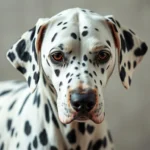
Introduction
Dog breeds are distinct categories of canines that share specific traits, characteristics, and physical appearances. Understanding different breeds is essential for prospective dog owners, as it helps them choose a companion that suits their lifestyle and preferences.
The Great Dane, one of the most recognizable dog breeds, has a rich history that dates back to ancient times. Originally bred for hunting large game, these gentle giants have become beloved family pets due to their friendly nature, loyalty, and impressive stature.
Among the many color variations of the Great Dane, the chocolate Great Dane stands out as a unique and striking option. This article will explore the characteristics, care, and considerations for those interested in this beautiful breed.
Characteristics of the Great Dane
Physical Attributes
Great Danes are known for their massive size and elegant stature. Adult males typically weigh between 140 to 175 pounds, while females range from 110 to 145 pounds. Their height can reach up to 34 inches at the shoulder, making them one of the tallest dog breeds in the world.
The coat of a Great Dane is short and smooth, requiring minimal grooming. While they come in various colors, including fawn, brindle, blue, and black, the chocolate coloration is particularly captivating. Chocolate Great Danes exhibit a rich brown coat that can vary in shade, often complemented by white markings.
Distinctive features of the Great Dane include their long, rectangular body, deep chest, and strong neck. Their ears can be cropped to stand erect or left natural, hanging down alongside their heads, giving them a gentle and approachable appearance.
Temperament
Great Danes are renowned for their friendly and gentle demeanor. Often referred to as “gentle giants,” they are affectionate, sociable, and good with children and other pets. Their protective instincts make them excellent watchdogs, as they are naturally alert and aware of their surroundings.
Despite their size, Great Danes are known to be calm and laid-back, often preferring to lounge around the house rather than engage in hyperactive play. However, they do require regular exercise to maintain their health and prevent obesity.
Health Considerations
With their size comes a range of health considerations. Common health issues in Great Danes include hip dysplasia and bloat, a potentially life-threatening condition that affects their stomach. Regular veterinary check-ups and a proper diet can help manage these risks.
The average lifespan of a Great Dane is approximately 7 to 10 years, but factors such as genetics, diet, and exercise can significantly influence their longevity.
Understanding the Chocolate Great Dane
Genetics of Coat Color
The chocolate coloration in Great Danes results from a recessive gene that affects the pigmentation of their coat. This unique genetic trait distinguishes them from other colors like fawn, brindle, and black. While breeders have focused on other colors historically, the chocolate variety has gained a following in recent years.
Rarity and Popularity
Chocolate Great Danes are relatively rare compared to other color variations. While their popularity has been steadily increasing among enthusiasts and families, they are not as commonly seen in dog shows. This rarity can make them more appealing to potential owners who are looking for something unique.
Implications of Color on Breed Standards
Breed standards set by organizations such as the American Kennel Club (AKC) influence the acceptability of various colors in shows and competitions. While chocolate is not traditionally recognized in all breed standards, it is gaining acceptance in some circles. Prospective owners should be aware of the specific breed standards in their area.
Care and Maintenance of Chocolate Great Danes
Diet and Nutrition
Given their size, chocolate Great Danes require a diet specifically formulated for large breeds. High-quality dog food that supports joint health and is rich in protein is essential. Owners must also manage their weight, as obesity can exacerbate health issues common in Great Danes.
Exercise Requirements
Great Danes need regular exercise to stay healthy. Daily walks of at least 30 minutes combined with playtime will help keep them fit. Activities such as fetch or gentle play sessions in a secure yard can provide the mental stimulation they crave.
Grooming Needs
The short coat of a chocolate Great Dane requires minimal grooming. Weekly brushing can help reduce shedding and keep their coat shiny. Bathing should be done as needed, typically every few months or when they become particularly dirty. Regular nail trimming and ear cleaning are also important for their overall hygiene.
Training a Chocolate Great Dane
Basic Training Techniques
Training is crucial for a chocolate Great Dane, especially given their size. Early socialization and obedience training will help them develop into well-mannered adults. Positive reinforcement techniques, such as treats and praise, are effective methods for encouraging good behavior.
Common Behavioral Issues
Like any breed, Great Danes can exhibit behavioral issues, such as jumping or excessive barking. Addressing these behaviors early with consistent training and positive reinforcement can prevent them from becoming problematic.
Advanced Training Opportunities
Great Danes have the potential for advanced training in obedience and agility. Engaging them in training classes not only enhances their skills but also provides mental stimulation and helps strengthen the bond between dog and owner.
Living with a Chocolate Great Dane
Space and Environment
Living conditions play a significant role in a Great Dane’s well-being. While they can adapt to apartment living, they thrive in homes with ample space to move around. A securely fenced yard is ideal for safe outdoor play.
Family Integration
Chocolate Great Danes integrate well into family life. Their gentle nature makes them suitable companions for children, and they often form strong bonds with family members. Introducing them to other pets should be done gradually to ensure a harmonious living environment.
Traveling with a Great Dane
Traveling with a large breed like the chocolate Great Dane requires careful planning. Owners should ensure their vehicle is spacious and comfortable for the dog. When booking accommodations, it’s essential to verify that they are pet-friendly and can accommodate a large dog.
Adoption and Buying Considerations
Adoption vs. Buying
Choosing between adopting a Great Dane or purchasing from a breeder has its pros and cons. Adoption can save a life and often comes with lower initial costs, while buying from a breeder may provide a dog with specific lineage and health guarantees.
Finding a Reputable Breeder
If choosing to buy from a breeder, it’s crucial to research and find a reputable one. Potential owners should ask questions about the breeding process, health testing, and the temperament of the puppies. Red flags include unwillingness to provide health clearances or a lack of transparency about the breeding environment.
Rescue Organizations
Many Great Danes in need of homes can be found in rescue organizations. These groups play a vital role in fostering and rehoming Great Danes, including chocolate variations. Adopting from a rescue not only provides a loving home but also supports the mission of rescuing and rehabilitating dogs in need.
Conclusion
The chocolate Great Dane is a magnificent breed that combines beauty, gentleness, and loyalty. Understanding their characteristics, care needs, and training requirements is essential for potential owners. While they come with their unique challenges, the joys of owning a Great Dane, especially one with such a rare coloration, can be incredibly rewarding.
Before bringing a chocolate Great Dane into your home, thorough research and preparation will ensure a smooth transition and a happy life together.
FAQs about Chocolate Great Danes
Common Questions
-
Are chocolate Great Danes more prone to health issues than other colors?
No, the color does not inherently affect their health. They share the same health risks as other Great Danes, such as hip dysplasia and bloat. -
What is the average lifespan of a chocolate Great Dane?
The average lifespan is around 7 to 10 years, similar to other Great Danes.
Myths and Misconceptions
-
Do chocolate Great Danes have different temperaments?
No, their temperament is consistent with that of other Great Danes, characterized by friendliness and gentleness. -
Are chocolate Great Danes recognized by kennel clubs?
Recognition varies by organization. While some clubs may not accept chocolate as a standard color, it is becoming more acknowledged within certain circles.
Understanding these aspects will prepare you for the joys and responsibilities of sharing your life with a chocolate Great Dane.









